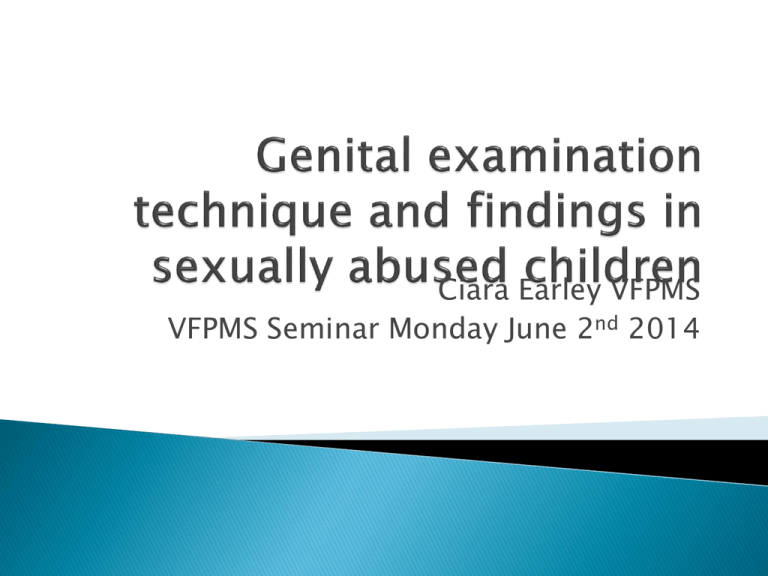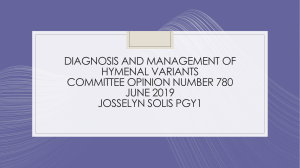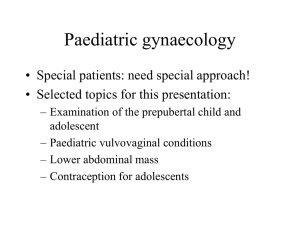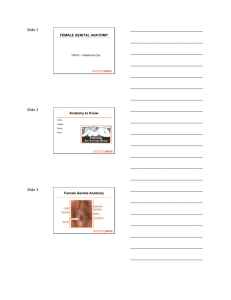
Ciara Earley VFPMS
VFPMS Seminar Monday June 2nd 2014
Timing of the examination,< 72 hours in
acute cases
Location
The purpose of the examination
The genital examination as a part of a
complete medical examination
Not just “hymenologists!”
Consent NB (Gillick competent, court order,
parental)
Equipment: Adequate light and privacy
Colposcopy recommended if available
Magnification and illumination, enables Peer
Review
Can be awkward and technically difficult in
younger children
Who else needs to be present ?
Comfortable position and clothing
The hymen as a clock face
Position of patient
Supine frog leg
Prone knee-chest
Left lateral
Supine knee chest
Labial
traction
technique
Don’t forget that the prepubertal hymen is
sensitive
Relaxation enables a better view of the hymen
Elevation of the pelvis may help visualisation
Reposition
Extra pair of hands!
Moistened swab in adolescents
May need a repeat examination in certain
cases
Several changes from neonatal period to
adolescence
Oestrogen effects may remain for the first
year or two
Pre-pubertal: Less oestrogen effect, thin
atrophic tissues,
Labia majora flat appearance, labia minora
thin,
Influence of Oestrogen returns
Thickened hymenal tissue with more elastic
and fibre content
Fimbriated appearance
Thicker tissues less vulnerable to damage and
infection
“The most insignificant anatomical structure
of the female without an analog in the male
has assumed a social importance at variance
with its almost neutral physiologic value or its
potential influence upon health”
Wile Is The Psychology of the hymen . J Nerv Ment Dis .1937
(Feb):143-156
Vary with age
Newborn hymens annular or
fimbriated
Hymenal configuration changed
in 65%
68% of hymenal tags present at birth
disappeared, 9 tags formed
Berenson, A, A longitudinal study of hymenal morphology in the first 3 years of life, Pediatrics 1995; 95: 490-496
Cresenteric configuration more common as
children aged
The number of mounds and intravaginal ridges
increased as the children aged
No deep notches or transections observed in
those who did not have a history of sexual abuse
A decrease in the amount of tissue in the
posterior hymen was noted but some tissue
always present
Berenson, AB, Grady, JJ, A longitudinal study of hymenal development from 3 to 9 years of age,
Journal of Pediatrics, 2002; 140: 600-607
Notches/cleft: an angular V shaped
indentation on the edge of the hymenal
membrane which does not extend right
through to the vaginal wall. Common at 3 and
9 o clock positions.
Bumps : Localised rounded areas of tissue
can be seen anywhere on the hymen
Berenson A.B. Normal anogenital anatomy. Child Abuse and
Neglect 1998;22(6) 589-96
Tags : Flaps or appendages extending more
than 1mm from the rim. Common in the
newborn
Hymenal Ridges : External ridges may be seen
at 12 and 6 oclock. Most easily observed at
birth . 86% of newborns in one study. Usually
tend to resolve
Berenson et al Appearance of the hymen in newborns Pediatrics
,87,458-465
Linea vestibularis : Pale midline avascular
streaks of the posterior vestibule
Median Raphe: More obvious in males also
present in females
Failure of midline fusion: The defect can
extend from the fossa navicularis to the anus.
The tissue at the base of the defect is pale
and avascular with smooth borders.
Periurethral bands
Normal
Non specific: Erythema
Concerning findings include:
Bruising or abrasions of the genitalia
Decreased amount or absent tissue in the
posterior aspect
Injury or scarring of the posterior
fourchette/fossa navicularis or hymen
Complete transection of the hymen
Deep hymenal cleft 3-9 oclock
Case control study “Most hymenal measurements lack sensitivity
or specificity to be used to confirm previous penetration”
Berenson A.B. et al Use of hymenal measurements in the
diagnosis of previous penetration Pediatrics2002;109(2) p 228235
Berenson et al A case control study of anatomic changes
resulting from sexual abuseAmJ Obstet Gynecol2000;182:82034
Vaginal discharge more common in abused children
A hymenal transection,perforation, or deep notch was observed
in 4 children all of whom were abused
Kellog N et al Genital Anatomy in Pregnant Adolescents: “Normal”
doesn’t mean “Nothing Happened”Pediatrics 2004;113e67-e69
Only 2/36 had definitive findings of penetration
Inspection of urethral meatus, foreskin and
penis
Scrotum and testes
Left lateral or supine knee chest
Lateral buttock separation technique not
recommended (post Cleveland inquiry
Several Non specific findings
McCann et al 318 children selected for non
abuse
Erythema 41%
Increased pigmentation 30%
Venous engorgement 52% (after 2 minutes
knee chest position)
“Smooth areas” 26% (always on midline)
Anal tags 11%
McCann et al Perianal findings in prepubertal children selected for non
abuse :a descriptive study.Child Abuse and Neglect1989;13(2)179-93
McCann study 49% of children ( AP diameter
<0.1cm-2.5cm , mean 1.0cm)
Small % (1.2%) > 20mm without the presence
of stool
Hobbs and Wynne “ Dilatation over 0.5cm
does not in our experience occur in normal
children”
McCann et al Perianal findings in prepubertal chilren selected for non abuse :a
descriptive study.Child Abuse and Neglect1989;13(2)179-93
Hobbs C.J. & Wynne J.M. Sexual abuse of boys and girls: The importance of
anal examination.Child abuse and Neglect 13 (2) : 195-210 1989
Cleveland inquiry : 125 children diagnosed as
sexually abused over a 5 month period.
Several other causes of anal dilatation
Chronic constipation
Crohn’s disease
Neurological disorders
During anaesthesia
Summary of the Cleveland Inquiry BMJ ;297: July 1988 : p190-191
Anal lacerations (may need further surgical
intervention/ EUA)
Anal tags outside the midline (not noted in
McCann’s study)
Important to correlate clinical findings and
relevant history and medical history
Berenson and McCann studies
Gall J et al Current Practice in Forensic
Medicine” chapter on “The paediatric hymen”
Child Abuse and Neglect , diagnosis,
treatment and evidence Carole Jenny. Chapter
10 &11
Child Abuse, Medical Diagnosis and
management 3rd edition Reece & Christian
The genital examination is only a part of the
overall evaluation of sexual abuse in children
Preparation is important
A detailed knowledge of normal anatomy and
variants is required
Most examinations are normal











